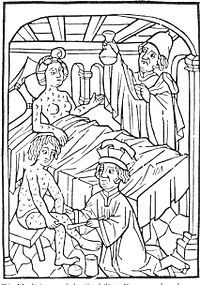
Photo from wikipedia
Background Some patients with early syphilis who receive appropriate treatment do not reach a serological cure and have a persistent titer which does not meet the criteria for treatment failure… Click to show full abstract
Background Some patients with early syphilis who receive appropriate treatment do not reach a serological cure and have a persistent titer which does not meet the criteria for treatment failure (serofast state). Aims This retrospective study aimed to determine the prevalence of serological cure and the serofast state as well as the factors associated with serological cure after treatment of patients with early syphilis. Methods A serological cure was defined as occurring when there was a ≥4-fold decrease in nontreponemal titer, whereas patients with a ≥4-fold increase were considered as having either a treatment failure or reinfection. Nontreponemal titers that neither increased nor decreased ≥4-fold after treatment were considered to be in a serofast state. Seroreversion was defined as occurring when there was a negative test within 12 months of treatment. Results There were 179 patients with a mean age of 31.9 years; 174 (97.2%) were men, and 125 (70%) were HIV patients. Of the total, 174 (98%; 95% confidence interval 94.82-99.42%) patients achieved a serological cure, whereas five were in a serofast state 12 months after treatment. Those five serofast patients were all HIV-positive men, of which 4 (80%) had secondary-stage syphilis, a CD4 count ≤200 cells/μl and a titer <1:8. In a bivariate analysis, a serological cure was associated with a baseline Venereal Disease Research Laboratory >1:16 titers (P = 0.018), and a CD4 cell count >200 cells/μl in 6 months preceding treatment (P = 0.016). The median time to a serological cure was 96 days. Only 22 (12.3%) of the patients achieved seroreversion at 12 months after treatment. Limitations A retrospective medical record review is likely to have a selection bias, and in our study, 196 (52%) patients were excluded due to missing information. Conclusions Most patients with early syphilis who achieved a serological cure at 12 months after treatment had high baseline Venereal Disease Research Laboratory titers and CD4 cell counts. However, only 22 (12.3%) had a negative Venereal Disease Research Laboratory titer after 1 year of treatment.
Journal Title: Indian journal of dermatology, venereology and leprology
Year Published: 2019
Link to full text (if available)
Share on Social Media: Sign Up to like & get
recommendations!